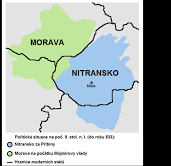Seriál slovenských dejín : 3.Misia sv.Cyrila a Metoda/ Serial of Slovak history: Mission of St.Cyril and Methodius- Tento seriál Je na počesť predsedníctva Slovenska Europskej únie/ This serial is in honor of the Slovak Presidium of the European Union
Knieža Rastislav sa chcel zbaviť silného vplyvu susednej Východo franskej ríše a jej biskupov a preto požiadal o pomoc cisára Byzantskej ríše-bývalá Východo rímska ríša (územie dnešného Grécka, Turecka ) Michala III., ktorý sídlil v Konštantínopoli-dnešný Istanbul. Ten jeho žiadosti vyhovel a poslal mu dvoch učencov Koštantína a Metóda, ktorí prišli roku 833 na Veľkú Moravu, aby tak šírili kresťanstvo medzi ĺuďmi v jazyku im zrozumitelnom v starej slovančine. Priniesli tiež bibliu preloženú do tohto jazyka, ktorú pápež Hadrian II. na ich žiadosť roku 867 v Ríme posvätil v kostole Panny Márii Snežnej a schválil používanie staroslovenčiny po latinčine, hebrejčine a gréčtine ako ďalšieho bohoslužobného jazyka. Filozof Konštantín pre chorobu sa nevrátil naspäť na Moravu , zostal tam v kláštore a prijal meno Cyril. Pápež Metóda vysvätil za biskupa Veľkej Moravy a neskôr aj Panónie,územie Slovanov, ktoré obývali v oblasti jazera Balatón , dnešné Maďarsko. Tu vládol Pribinov syn Koceĺ, ktorý Metóda na ceste na Moravu , keď sa zastavil u neho poslal s týmto cieľom späť do Ríma k pápežovi. Metóda na ceste späť na Moravu dali zajať franskí biskupi a uvrhli ho do väzenia, odkiaľ sa mu podarilo dostať na základe rokovaní medzi pápežom a východo franským kráľom Ľudovítom Nemcom. Metód tak vytvoril svoju slovanskú cirkevnú diecézu na Veĺkej Morave a pokračoval v škole so staroslovanským vyučovacím jazykom pre výchovu slovanských kňazov, ktorú predtým založil. Po jeho smrti roku 885 jeho nástupca Gorazd, pochádzajúci zo Slovenska a jeho žiaci v dôsledku intríg východo franských kňazov, zástancov latinskej liturgie boli uvrhnutí do väzenia a vyhnaní z Veľkej Moravy. Stalo sa to vlády Svätopluka, kedy na čelo moravskej diecézy bol dosadený východo franský mních Wiching. Význam misie Cyrila a Metóda je predovšetkým v tom, že na území Slovenska a Čiech položili základy kultúrnej vzdelanosti všetkých Slovanov v ich staroslovanskom jazyku a šírili v tomto jazyku vo vtedajšej Európe novú životnú filozofiu kresťanstvo. V ich diele pokračovali medzi Slovanmi juhovýchodnej Európy hore spomínaní vyhnanci , ktorí vytvorili cyriliku, ktorá nahradila hlaholiku.
Prince Rastislav wanted to get rid of the strong influence of neighboring Eastern Frank empire and its bishops and therefore asked for help from the emperor of the Byzantine Empire-old Eastern Roman Empire (territory of modern Greece, Turkey), Michael III., who resided in Constantinople-Istanbul today. He was granted his request and sent him two Philosophers Constantine and Methodius, who came in 833 to Great Moravia in order to spread Christianity among the people in a language they can understand the old Slavonic. They brought also translated the Bible into this language and it had been sanctified by Pope Hadrian II. at their request in 867 in Rome in the Church of Our Lady of the Snows. Old Slavonic became for use after Latin,Hebrew, Greek as an additional language of worship. Constantine the Philosopher for the disease has not returned back to Moravia, he stayed there in the monastery and took the name Cyril. Method had been consecrated by pope a bishop of Great Moravia and later also Pannonia, the territory Slavs who lived in Lake Balaton, Hungary today. That made Pribina’s son Koceľ whom Methodius on the way to Moravia sent back to the pope when he stopped at him. Method on the way from Rome back to Moravia gave capture Frankish bishops and threw him into prison. He had became free through negotiations between the Pope and the Eastern Frank King Louis the German. Methodius had created his Slavonic Church diocese in Great Moravia and continued in school with the Slavic languages of instruction for education Slavic priests who previously founded. After his death in 885 his successor Gorazd, coming from Slovakia and pupils due to intrigues of the Eastern Frank priests, proponents of the Latin liturgy were thrown into prison and expelled from Great Moravia. It happened governments Svätopluk when forehead Moravian diocese of the Eastern monk was installed Wiching. Meaning mission Cyril and Methodius is above all in the fact that in Slovakia and the Czech Republic laid the foundations for the cultural education of all Slavs in their Slavonic language and spread this language in the then Europe a new life philosophy Christianity. Their work continued among the Slavs of South East Europe aforementioned storage exiles who created the Cyrillic alphabet, which replaced the Glagolitic.

